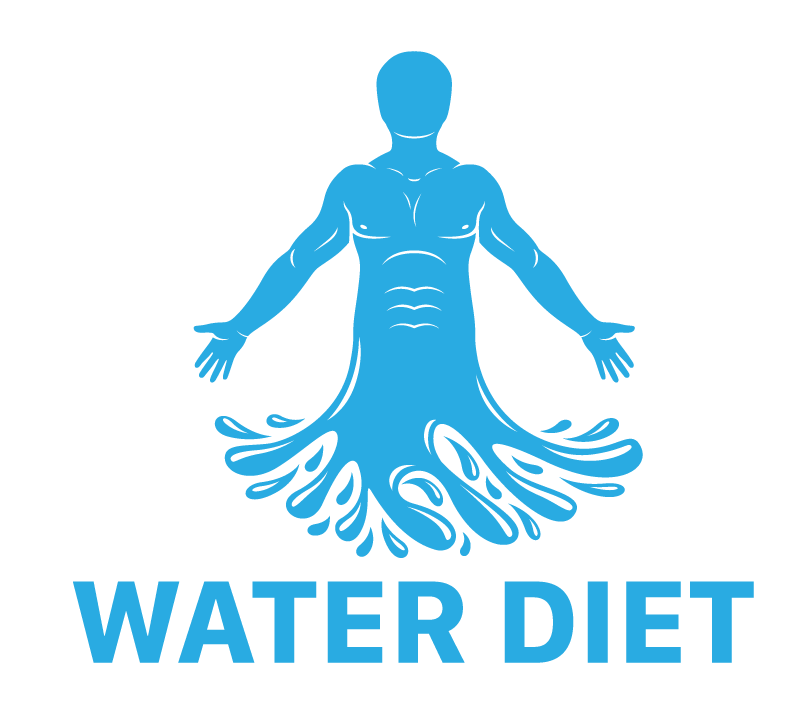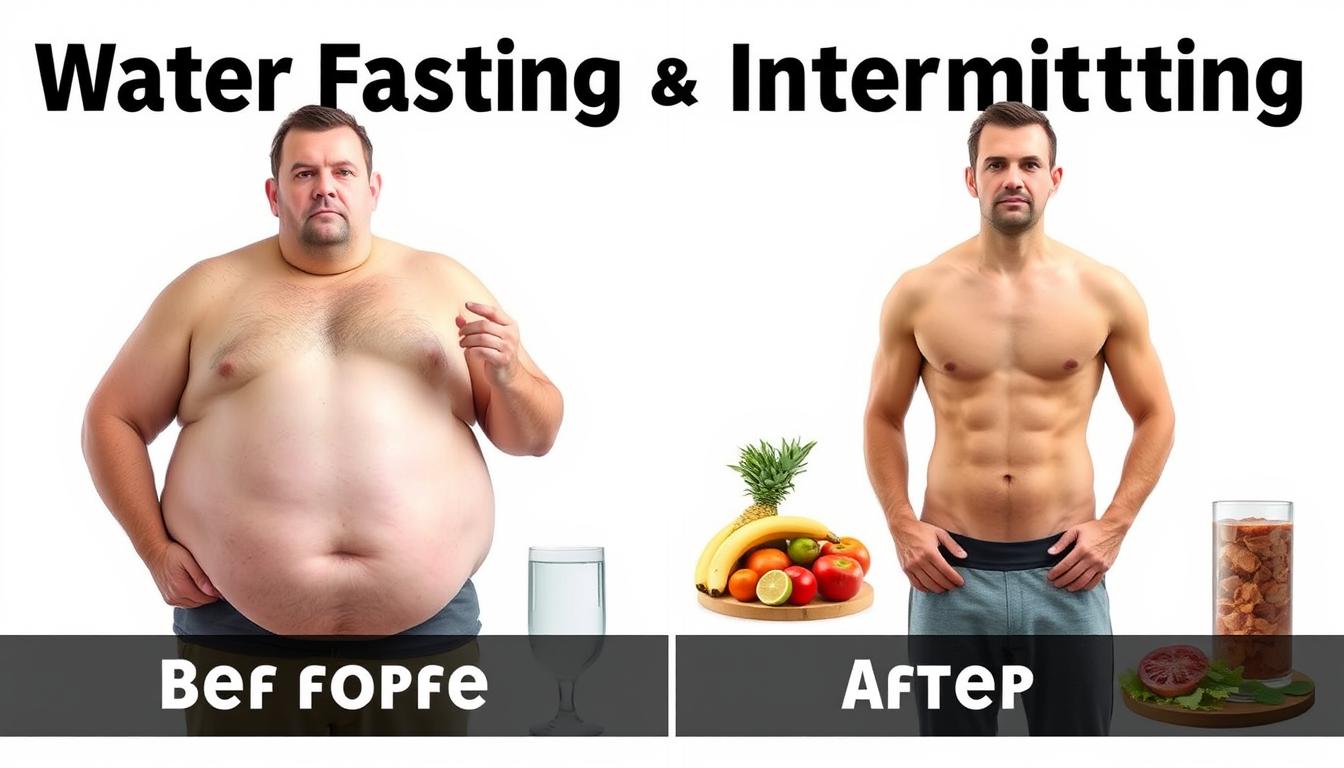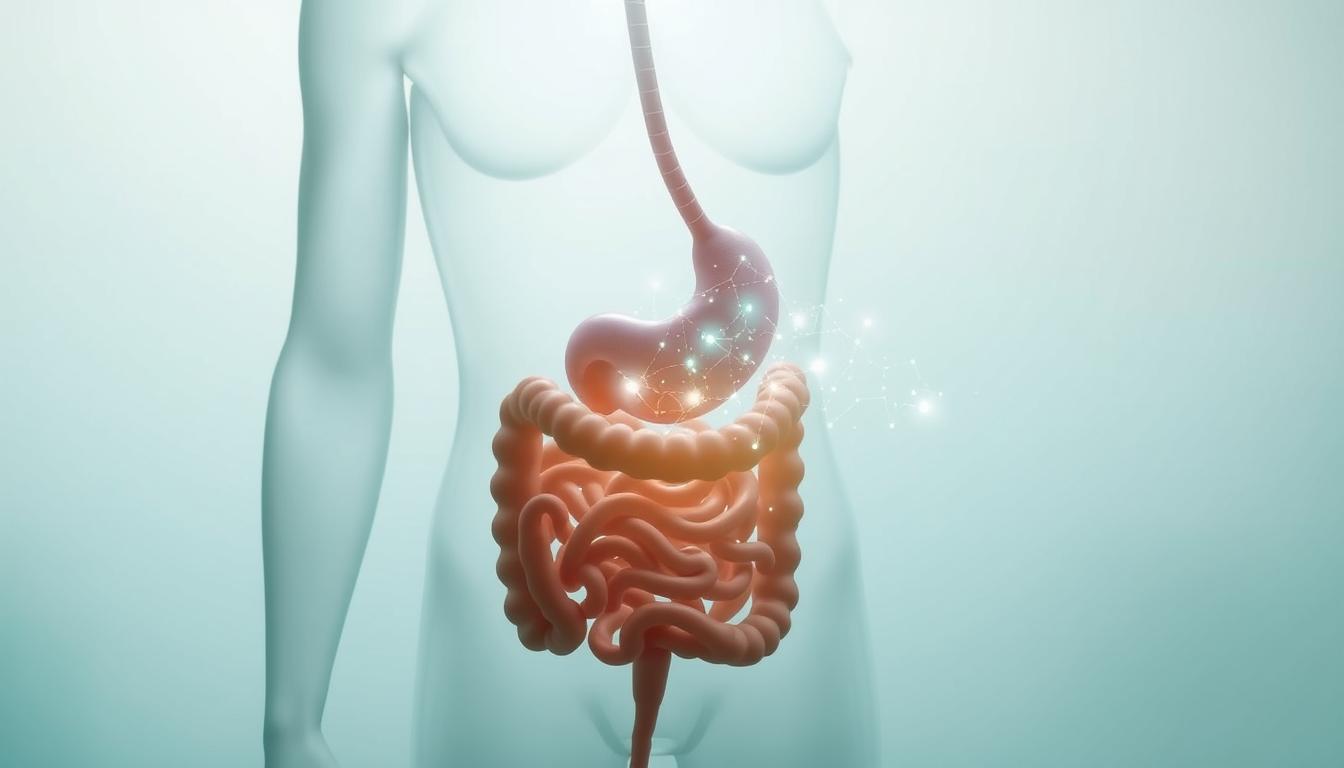Many people are now using fasting to lose weight and boost their health. Two methods, water fasting and intermittent fasting, are getting a lot of attention. Together, they make a strong pair that helps burn fat and keep your metabolism healthy.
Intermittent fasting means eating and fasting at set times. It helps with weight control and can prevent or even reverse some diseases. Water fasting, on the other hand, is when you only drink water for a while. It’s becoming popular for losing weight and feeling better overall.
When you mix water fasting with intermittent fasting, you get the best of both worlds. These methods work together to burn fat, improve your metabolism, and offer many health benefits. Even though fasting might seem tough at first, with the right plan and advice, it can be a lasting and effective way to reach your weight loss goals.
Key Takeaways
- Intermittent fasting and water fasting are strong ways to lose weight that work well together.
- Intermittent fasting switches between eating and fasting times. Water fasting means only drinking water for a certain period.
- These fasting methods help burn fat, improve metabolism, and have many other benefits.
- Combining water fasting with intermittent fasting creates a powerful effect for losing weight and feeling better.
- Having a good plan and advice is key to successfully doing a fasting program and seeing lasting results.
Understanding Intermittent Fasting for Weight Loss
Intermittent fasting is a popular way to lose weight and improve health. It involves eating and fasting at different times. This can lead to eating less and changing how your body uses energy, helping you burn fat.
How Intermittent Fasting Works
Intermittent fasting makes your body use stored fat for energy after a few hours without food. This is called metabolic switching. Unlike eating all day, fasting helps your body burn fat instead of sugar.
Different Intermittent Fasting Plans
There are many ways to do intermittent fasting, each with its own rules:
- 16/8 Method: Fast for 16 hours a day and eat in an 8-hour window.
- 5:2 Diet: Eat normally for 5 days and eat very little on 2 days.
- Time-Restricted Eating: Eat only during a 6-8 hour window each day and fast the rest of the time.
| Fasting Method | Fasting Period | Eating Window |
|---|---|---|
| 16/8 Method | 16 hours | 8 hours |
| 5:2 Diet | 2 non-consecutive days | 5 days |
| Time-Restricted Eating | 16-18 hours | 6-8 hours |
Benefits of Intermittent Fasting Beyond Weight Loss
Intermittent fasting does more than help with weight loss. It also offers many health benefits, such as:
- Better blood sugar control and less inflammation
- Improved brain function and protection against brain diseases
- Longer life and better heart health
- Preventing obesity and type 2 diabetes
During fasting, your body cleans out damaged cells and makes new, healthy ones. This is called autophagy.
Adding intermittent fasting to your life can lead to better fat burning and many health perks, not just weight loss.
Exploring Water Fasting and Its Potential Benefits
Water fasting is becoming more popular for weight loss and better health. It means not eating and only drinking water for a while, from a few hours to several days. This method might seem strict, but it can be good for health when done right and with a doctor’s advice.

What is Water Fasting?
Water fasting means drinking only water and not eating for a certain time. You might drink zero-calorie drinks like black coffee and tea, but water is the main drink. There are different ways to do water fasting, such as:
- 16/8 intermittent fasting: This means not eating for 16 hours and eating during an 8-hour window.
- 24-hour fasts: Not eating for a full day, often once or twice a week.
- Prolonged fasts: Fasting for 48-72 hours or more, which should only be done with a doctor’s help.
Potential Health Benefits of Water Fasting
Studies show water fasting might have many health benefits, like:
- Improved insulin sensitivity: Not eating can lower blood sugar and help people with diabetes.
- Increased lipolysis: It may break down fats, leading to weight loss. But, it can also make you lose muscle.
- Better cardiovascular health: It could help keep the heart healthy by lowering blood pressure and improving cholesterol.
| Study | Findings |
|---|---|
| Sadeghirad et al. (2014) | Islamic fasting had a significant impact on weight loss |
| Harris et al. (2018) | Intermittent fasting helped overweight and obese adults manage their weight |
| Guerrero et al. (2021) | Intermittent fasting diet improved body measurements, body composition, and cholesterol levels |
These benefits sound good, but be careful with water fasting. Always do it with a doctor’s advice to stay safe and avoid risks.
Combining Water Fasting with Intermittent Fasting: A Powerful Weight Loss Duo
Combining water fasting with intermittent fasting can greatly help with fat loss. Water fasting means only drinking water for a while, which can start ketosis. This is when your body uses fat for energy, great for those stuck in a weight loss plateau. Research shows that exercising without eating can burn up to 20% more fat than eating before exercise.
Adding intermittent fasting to water fasting boosts both methods’ benefits. By fasting and eating at set times, like the 16/8 or 5:2 diets, you can lose more fat and keep muscle. This method also lowers insulin resistance, which helps prevent diseases like pre-diabetes.
Working out while fasting can release Human Growth Hormone (HgH), helping burn more fat and fight aging. The best time to exercise is important for the best results:
- Start with low-intensity workouts like Pilates or Yoga, anytime during your eating or fasting period.
- For burning fat, do fasted cardio like running or biking, wait 2-3 hours after to eat for the best effects.
- Strength training is best done a bit before eating or early in your eating window to help muscles recover without losing them.
- High-Intensity Interval Training (HIIT) works well right before or after eating to mix cardio and strength training.
The last meal before exercise is key for energy during the workout, focus on proteins and fats, not simple carbs. Start your day with foods that have proteins, complex carbs, fats, and fiber, changing it up on rest days.
Fasting improves insulin sensitivity, helps repair cells, and boosts brain function. Combining fasting with exercise makes fat burning more efficient, leading to better endurance and performance. In a fasted state, your insulin levels go down, making it easier to use stored fat for energy, speeding up weight loss with exercise.
When fasting and exercising, remember to stay hydrated, choose low-intensity activities during long fasts, time your workouts for energy, and eat nutritious food after exercising.
Switching between water fasting and intermittent fasting can be a lasting way to lose weight and improve health. But, pay attention to how your body reacts and adjust as needed. Finding the right balance and making fasting part of a healthy life can unlock the full potential of this weight loss duo.
Safety Considerations and Precautions for Fasting
Water fasting and intermittent fasting can help with weight loss and better health. But, they’re not for everyone. A study by Wilhelmi de Toledo et al. (2013) says some people should avoid fasting or do it with a doctor’s watchful eye. This is because fasting might make health issues worse or cause new problems.

Who Should Avoid Water Fasting and Intermittent Fasting
Some groups should not try water fasting or intermittent fasting. These include:
- Children and teenagers
- Pregnant or breastfeeding women
- Elderly individuals
- Those with chronic health conditions such as diabetes, gout, or heart disease
- People with a history of eating disorders
For those with eating disorders, fasting can lead to unhealthy habits and thoughts. This is shown in the work of Westmoreland, Krantz, and Mehler (2016). If you’re in one of these groups, talk to a doctor before starting any fasting plan.
Potential Side Effects and Risks
Even healthy people can face side effects and risks from fasting. Short-term issues might include:
- Fatigue
- Headaches
- Dizziness
- Low blood sugar
- Nausea
If these symptoms get worse or don’t go away, stop fasting and see a doctor. Long-term fasting, like water fasting, can cause serious problems like electrolyte imbalances and nutrient shortages. This is why it’s important to fast under a doctor’s guidance.
| Potential Risk | Description |
|---|---|
| Electrolyte Imbalances | Long fasting periods can mess with the balance of important electrolytes like sodium, potassium, and magnesium. This can lead to heart rhythm issues and other serious problems. |
| Nutrient Deficiencies | Not eating for a long time without supplements can lead to a lack of vitamins and minerals. This can harm your body’s functions and overall health. |
| Refeeding Syndrome | Coming off a long fast too quickly can cause refeeding syndrome, a serious condition. Eating slowly after fasting can lower this risk. |
Short-term studies show that intermittent fasting is usually safe with few bad effects. But, its long-term effects on health are still unknown. Always be careful with fasting and talk to a doctor to stay safe and avoid risks.
Tips for Successfully Implementing a Fasting Protocol
Starting a fasting journey can change your life if you want to lose weight and get healthier. But, it’s key to be careful and ready to make it work. Start slow, drink lots of water, and eat well when you break your fast to enjoy fasting’s benefits safely.
Starting Slow and Gradually Increasing Fasting Periods
Beginners should start with short fasts and slowly increase the time. This helps your body get used to not eating as much. Try different fasting methods like the 16/8 or 5:2 diet to see what fits your life and goals.
Begin by eating less and eating less often to adjust. As you get used to it, you can try fasting for longer periods. Always listen to your body and go at a pace that feels right for you.
Staying Hydrated During Fasting
Drinking enough water is key when you’re fasting. Since food gives us a lot of fluids, you need to drink more water. Try to drink 8-10 glasses of water a day. You might also want to add coconut water or bone broth to get important minerals.
For long fasts, you might need extra electrolytes like sodium and potassium. A doctor can help make sure you’re getting what you need and avoid problems.
Breaking Your Fast with Nutritious Foods
When you stop fasting, eat foods that are good for you. Choose fruits, veggies, lean meats, and whole grains to get vitamins and minerals. Don’t eat too much or choose high-calorie, processed foods to avoid undoing your fasting progress.
After a long fast, eat small meals to help your stomach adjust. This can prevent problems like refeeding syndrome and make going back to eating normally easier. Eating well after fasting helps your body heal and keeps you from gaining weight back.
| Fasting Protocol | Description |
|---|---|
| 16/8 Method | Fast for 16 hours, eat during an 8-hour window |
| 5:2 Method | Eat normally for 5 days, restrict calories to 500-600 on 2 non-consecutive days |
| Eat-Stop-Eat | Fast for a full 24 hours once or twice a week |
Long-Term Sustainability and Maintenance After Reaching Weight Loss Goals
Reaching weight loss goals through fasting is a big win. But, keeping those results needs a long-term commitment to a healthy lifestyle. It’s important to stick with eating habits that last and keep up with regular exercise. Seeing fasting as part of a bigger move towards better health helps manage weight and overall health.
As you move forward in your weight loss journey, it’s key to keep an eye on and tweak your fasting plans. You might try different types of fasting, like the 16/8 or 5:2 method, to see what fits your life best. Remember, fasting helps in the short term, but lasting weight control comes from steady, healthy habits over time.
Weight gain after losing weight is common, and having a plan for it is crucial to stay on course. This could mean meal planning, managing stress, and having a support network of friends, family, or experts who can cheer you on and keep you accountable. By sticking to your healthy ways and being ready for challenges, you can keep your weight loss and enjoy better health and well-being.




